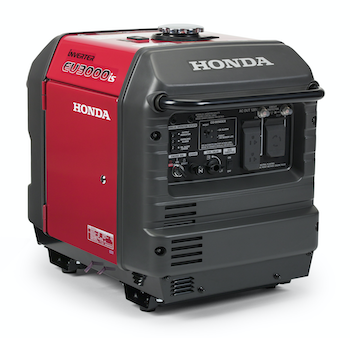Protect generator users from carbon monoxide
Honda Power Equipment launches CO-Minder advanced carbon monoxide detection system across entire generator lineup by end of 2020.
Honda Power Equipment is taking a bold step in generator safety by equipping all models in its portable generator lineup with CO-Minder, a new advanced carbon monoxide (CO) detection system designed to help protect users from injury or death from accidental carbon monoxide poisoning.
 |
| Honda Power Equipment will roll out the CO-Minder technology on existing generator models throughout 2020, starting in July with four models. |
The Honda CO-Minder system continuously measures carbon monoxide levels in the air near the generator and automatically shuts down the unit before detected CO reaches a dangerous level. Honda Power Equipment is first in the industry to commit to installing CO detection systems on its full line of generator models.
Generators must be used outdoors and away from windows and doors to prevent the buildup of carbon monoxide, a colorless, odorless, tasteless, and deadly gas. Even outdoors, if there is no wind, it is possible for CO to accumulate to life-threatening levels in certain locations, such as under the tongue of a fifth wheel recreational vehicle.
Honda Power Equipment will roll out the CO-Minder technology on existing generator models throughout 2020, starting in July with four models—the EU1000i and EU3000iS Super Quiet Series inverter generators for work, home, and recreational applications; the Economy Series EG4000 open-frame unit for home backup and workplace power; and the EB10000 Industrial Series generator, the company’s flagship model. By the end of this year, all Honda portable generator models will feature the CO-Minder carbon monoxide detection system.
The Honda CO-Minder carbon monoxide detection system incorporates a robust, fast-reacting sensor that continuously monitors for carbon monoxide in the air near the generator. If the sensor detects a CO level at or exceeding 800 parts per million (ppm) at a given time, or an average of 400 ppm for 10 minutes per Portable Generators Manufacturers’ Association [PGMA] G300-2018 standards, it triggers the generator to shut down automatically. A safety light on the main panel notifies the user that a buildup of carbon monoxide caused the generator to shut down.
Sources report that Honda designed the CO-Minder system to be fast acting, reducing nuisance shutdowns from false positives. Slower CO sensing systems must respond to dangers at a lower CO concentration in order to react in time to shut down the generator. Lower, temporary concentrations of CO can occur in certain conditions, such as when a gust of wind blows exhaust back toward the sensor, creating a false positive, a shutdown, and an inconvenience to the user. The Honda CO-Minder system is an improvement over those systems.
The Honda CO-Minder carbon monoxide detection system is built with a comprehensive range of safety features. The system is not intended to be overridden or tampered with, and the sensors are designed to work even if they are accidentally blocked. The sensors, with the widest temperature operating range of any existing CO monitors for generators, match the design running temperatures of Honda generators, allowing for use anywhere in the U.S. Both moisture and dust resistant, the sensors are designed for years of use. Further, the generator sensor system automatically tests itself and is equipped with a built-in warning, alerting the user to replace the sensors prior to end of life. Finally, the sensors conform to the American National Standards Institute (ANSI) PGMA G300-2018 quality standard established for carbon monoxide monitors for generators.
Labels on the Honda generator models equipped with the CO-Minder carbon monoxide detection system contain additional safety information, such as an exhaust directional safety warning decal, an anti-tamper message, and information on restarting the generator after an automatic CO-related shutdown.
Operating a Generator
Take it outside! As the only safe place to operate a portable generator, taking it outside is absolutely mandatory to keep your family safe from carbon monoxide. But there's even more you can do. By educating yourself about all carbon monoxide risks, you'll be better prepared to protect your family from this colorless, odorless threat. The Portable Generator Manufacturers’ Association (PGMA) provides a fact sheet and website dedicated to safe portable generator operation, the information can be found at http://www.takeyourgeneratoroutside.com/.










